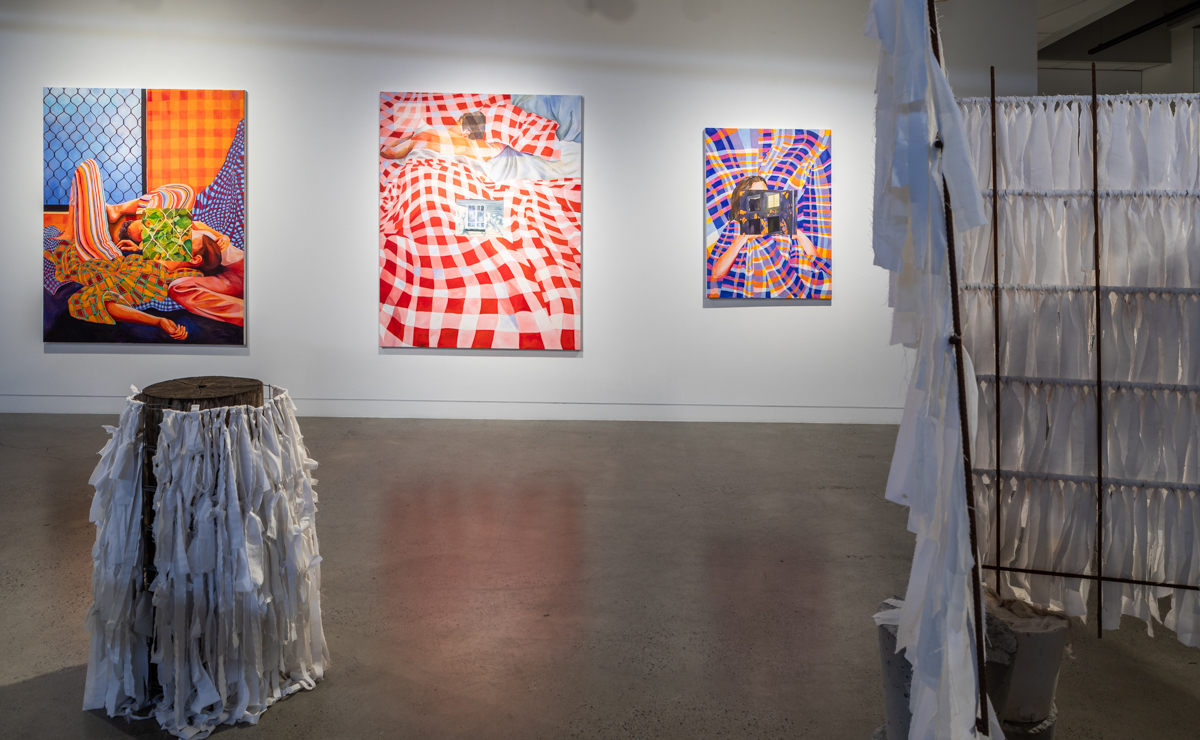The jacarandas are shedding and the bougainvilleas along Queensland College of Art (QCA) Southbank campus are flowering: it’s graduation season, and budding artists have well and truly unfurled at this year’s Honours and Masters of Visual Art showcase.
Although impossible (and perhaps unfair) to group together student work for the purpose of a review, iterations of the female experience are an undeniably common thread in this year’s showcase. Through the floor to ceiling windows of QCA’s Grey Street Gallery, I spot a standout work within this theme. The ghost of milk fingers gives a soft kick by Mia Gribbin perches, endearingly awkward on concrete feet. Tiers of bed sheets, which are laboriously but imperfectly snipped, torn, and tied to a rusty wire grid, give the impression of a deconstructed bed or perhaps an ancient relic (both steeped in metaphor). The most intimate aspect of the work is almost missable in the noise of opening night: a soundscape of the artist’s voice whispering “snip, cut,” in a looping chant. To decipher the audio, I crouched next to the work and hovered my ear by the fabric and rust (which also gave me a soft kick to recall the last time I had a tetanus shot). The work could be interpreted as an obvious commentary on gendered labour, however, experiencing the work was more like a warm embrace, a conversation, or what the artist describes as an ‘embodied experience.’
Hanging adjacent to Gribbin’s work is Jasmin Harris’ bold triptych. Nondescript figures lounge in checked blankets, obscured by a small, overlapping fragment. The effect has viewers subconsciously peering around the fragments to better glimpse the subject. In one, a figure clutches a checked blanket to her chin in an attempt to cover herself. In this way, viewers are positioned as voyeurs, with the obscuring fragment held up to the viewer (or voyeur) in the same unsettling way that one might open one’s phone to take a photo of something, only to be confronted with selfie-mode. In contrast, Shannon O’Hara’s abstract works appear approachable and refreshingly playful. O’Hara’s diptych, titled The Girls, suggests a foray into pop culture, with unashamedly feminine pink and purple satin stretched like a ‘trendy’ dress across the frame. O’Hara’s feminine reinterpretation of abstraction scratches the itch of the underestimation of the ‘girly’ (think of the Taylor Swift phenomenon). Yongyan Li’s soft pastel works on paper, which re-approach the female form, and Rylee McArthur Pittman’s Selfish Performance also work within this theme.
Perhaps the busiest gallery—both in visual impact and number of attendees—was the Webb Gallery. Indeed, one could mistake this space for a commercial gallery, and I am reminded of the advantages of curation and setting when showcasing works in their best light. Here, works by Liam Johnston, Imogen Corbett, and Alexandra Baxter were most impactful. If opening night sales are an indicator of success, Alexandra Baxter’s breathtaking cyanotypes are a clear favourite, with swathes of admirers crowding around the glowing prints. Johnston’s larger than life wall print Love lock imposes quite literal digital overwhelm on audiences to great effect, while he also demonstrates depth of practice through an intriguing, flickering work projected into a bathtub. Between the multi-sensorial experiences of Baxter and Johnston’s work, hung four quieter (yet no less impactful) oil paintings by Imogen Corbett. In stunning realism, the paintings present domestic interiors. However, rather than depicting candid scenes, the figures are arranged theatrically, and stare unflinchingly at the viewer.
muruku by Ivy Minniecon is another highlight. Three bronze cast baljis (woven baskets) were resplendent in the foreground of the artist’s body of work. Minniecon describes the work as representative of the most important figures in her life, with the bronze cast baljis indicating each of her children. Dangling above are several more baljis, like cocoons (in the artist’s words), each with a tag displaying their date of completion. The artist refers to the baskets as receptacles of healing, akin to journal entries. In turn, the work generously invites viewers to witness the artist’s journey. In the Project Gallery, Matthew Hurdle’s Your teeth fell out and I did nothing (sackcloth and ashes) also caught my eye. Varying shades of rectangular blind embossed hessian and ash are hung in a grid, like staccato notes, with the darkest editions rising to a crescendo in the centre of the work. The religious symbolism of ash and sackcloth hold a tension between suffering and forgiveness, which begs for further contemplation.
Although all of the exhibiting artists deserve far more in-depth explorations of their work, I have a feeling there will be no shortage of exposés for each artist in their careers to come.
Expanded Lemonade coverage of 2023 graduate exhibitions was kindly made possible by Lemonade’s Patreons and generous contributions from Alex Baxter, Amanda Bennetts, Kylie Harries, Lynn Hughes, Kit Kriewaldt, Pippa Macgill, Merilyn & Steve Mayhew, Doug McNeill, Annelize Mulder, Jane Orme, Alethea Richter, Monica Rohan, Adrian Smith, Gavin Smith, Leisa Turner, Hannah Williamson, and Nadya Wilson.
Prudence Osborne is an arts worker, arts educator, and writer living on Gubbi Gubbi ( Kabi Kabi) country.








